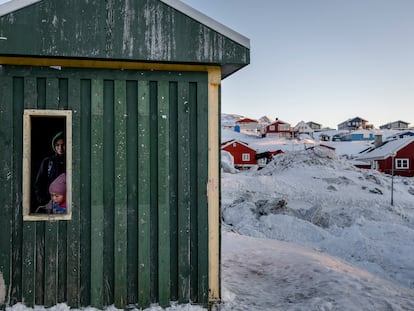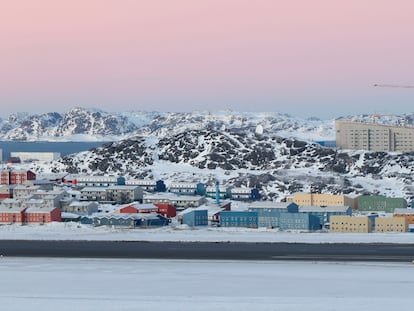Greenland: The land of suicides
The island that Donald Trump hopes to control has one of the highest rates of people taking their own lives. Decolonization and loss of identity have created a contagious spiral that is difficult to break
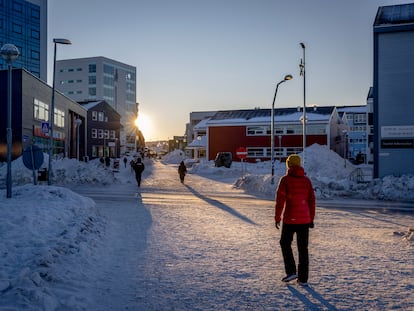

Everyone in Greenland knows someone close to them who has taken their own life. A good friend, a relative, a brother, or a neighbor. A parent, a sister, a classmate, or a pupil. It is impossible to find — this journalist did not find — a single person on this frozen island who has not been robbed of someone by suicide at one stage or another in their life. Doris Jakobsen, a member of parliament for the Social Democrat Siumut Party, 50: “Of course I know them. In fact, that was one of the reasons I got into politics.” Rikke Ostergaard, a 48-year-old graduate in social sciences: “Of course I know them. Just like everyone else. Here, you are born, go to school, grow up, become a teenager, smoke your first cigarette, have your first boyfriend, your friend kills themselves, you finish school… It is part of everyone’s biography.” Poul Pedersen, social worker, 30: “My best friend and my cousin killed themselves. And my best friend killed herself years after her little sister did. Every time someone kills themselves here, we ask ourselves: Who will be next?” Maliina Abelsen, sociologist, 48: “I know at least 10 people.”
Greenland, immense and empty, the size of Mexico, almost entirely buried in ice, inhabited by just 57,000 people — and which Donald Trump now aspires to turn into part of the United States — has one of the highest suicide rates on the planet. The global average is nine people per 100,000 inhabitants per year. In Spain it is around seven. In Russia, 25, according to 2019 data from the World Health Organization. In Greenland, according to various studies, it does not fall below 80. And it has been much worse: in 1989 the suicide epidemic reached an almost inconceivable 120 people. During that time, experts considered that Greenland held the strange title of being the place on earth with the most suicides.
It is easy to look around and, almost automatically, point to the culprit: the lack of light, the extreme climate, the loneliness, the extraordinarily beautiful but also incredibly hostile environment that shapes every minute one spends in Greenland. In winter, dawn breaks at 11 a.m. and it is not unusual to go to work in a temperature of 5ºF (-15ºC), with a bright moon hanging high in the sky. Clear days can be freezing, like last Tuesday, when it reached 1ºF (-17ºC) because a northern wind was blowing that originated precisely at the North Pole; cloudy days, like Thursday, sometimes bring snowstorms that make the task of walking down the street a feat. On days like this — on nights like this — there is absolutely no one outside.

But the explanation is not that simple. There is no study showing that suicides in Greenland occur less frequently on summer days, when daylight is permanent and the sun dances over the heads of Greenlanders 24 hours a day.
There are old Inuit stories. They say that when the elderly felt useless, they would go to a cliff and jump into the sea so as not to be a burden on the rest of the community. But, although everyone here knows these stories, specialists warn that they are just that: stories. In fact, the people who most often take their own lives on the island are young men aged between 20 and 24. Suicides, however, are more frequent among the Inuit, who make up 90% of the population, than among the remainder. Another factor cited is the massive presence of firearms in the hands of a people skilled in reindeer, seal, and caribou hunting who know how to use them. But studies show that the most common method of suicide in Greenland is hanging.
Suicide rates are currently soaring in the towns and villages in the eastern part of the island, the most remote communities. In Greenland there are no roads beyond those that link the capital Nuuk with its outskirts and which end, for example, at the university or at the cemetery, which on winter days is completely covered in snow, with the disconcerting white crosses on the graves sticking out above. Communication between towns spread along the coast and hundreds or thousands of miles apart depends on ships, light aircraft, or helicopters that, as was the case last Wednesday, can be grounded due to a sudden snowstorm.
Nuuk, with a population of 20,000, has restaurants, shops, many company headquarters, a national museum, a university, a cultural center, a shopping mall and several supermarkets. There are even street stalls selling electronic devices and woollen hats, coats, and down jackets. Everything is laid out on cardboard so that it doesn’t get damaged by the snow. Life is expensive, but salaries are also comparable to those in Denmark, the country to which this autonomous territory belongs.
In the towns and villages of the east, there is nothing like this. The consumption of alcohol and associated problems have reached such a level that the authorities banned the sale of drinks with more than a 15% alcohol content in certain towns in the east of the island years ago. But the black market is still active. A small bottle of vodka can cost over $60. In addition to the high levels of alcohol abuse, there are also high rates of sexual abuse and domestic violence.
To try to understand the phenomenon, we must trace its origins. Because it was not always like this. A report published in March 2023 in the journal BMC Psychiatry that analyzed suicides in Greenland from a historical point of view concluded that people who took their own lives began to do so en masse only from the 1960s onward. In the 1970s, the rate reached 28.7 people per year. It continued to rise until the aforementioned peak in 1989, when it reached 120. Both in Nuuk and in the rest of the island. Over time, the rate fell — especially in the capital — until it stabilized, on average, at the current 80.
There have been several campaigns by the Greenlandic government to try to tackle the problem. Measures such as telephone help for people with suicidal thoughts or compulsions have also been introduced. But so far, the rate has not been brought down. The study adds that the increase in suicides was linked to the progressive modernization and westernization of the island: the fact that it was no longer a community of Inuit fishermen and hunters and became something else.
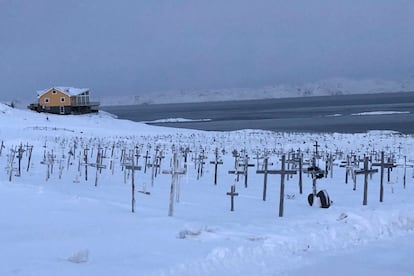
Identity torn away
Sociologist Maliina Abelsen has been studying the issue for many years and is clear about where it comes from: “I’ve travelled to Australia and New Zealand and Canada, and it’s been the same story in all colonized societies, and they have similar suicide rates. And in Australia it’s sunny. It’s not cold. Like in New Zealand. When you’re torn away from your own language, your own culture, your own identity, you feel alienated from society and from yourself. And instead of taking that frustration externally and sparking a revolution, you turn it inward and blame yourself for not being good enough.”
Abelsen recounts stories of Inuit sent to Denmark to study, “like my own father,” who after spending more than 10 years in Copenhagen, completing their high school diploma and a degree, returned to Greenland uprooted and unsure of their place in society because they did not feel completely Danish, but neither did they feel completely Greenlandic. “My father was on the verge of losing our language,” she explains.
Added to this was the almost forced displacement of thousands of fishermen and hunters from villages throughout the 1970s, who had to go and live in the capital. “Many felt like they were living in a zoo,” says Abelsen. “And when you strip someone of what they are made of and they lose their identity, what follows is alcohol, and abuse, and violence, and suicide.”
According to this specialist, the escalation in suicides created a “negative spiral” in Greenlandic society, a kind of contagious disease that was passed on from generation to generation. “Suicides became a pattern, an epidemic. A familiar way out. Something that was customary. I know many young people whose best friend took their own life and that led them to think that they had not been good friends, that they did not deserve to live because of that, and they ended up killing themselves too. So the disease spreads. That is what I call the negative spiral. Like drinking.”
How can the situation be reversed? “Well, by opening up society to heal all the traumas that we carry around, both individual — such as guilt or alcoholism or lack of identity — and collective traumas, which are often related to our relationship with Denmark, because we have created a society based on the notion that we are not as good as the Danes. That is what my generation believes. But the new generations no longer think that way.”
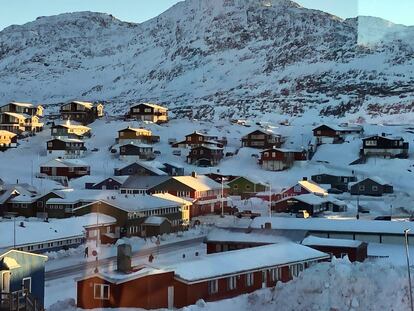
Social worker Paul Pedersen agrees that this is a domino effect: “One case leads to another, and that case infects another, and so on. You never know when it will end.” He is not in favour of generalizing, but he does point to a cause that is rooted in the character of the Inuit people. “I lived in Denmark for a few years. And I was amazed at the degree of foresight in everything. Sometimes someone would arrange to meet you for a coffee three months in advance! We are not like that. Maybe it is because of the climate, but we know that it is not worth planning everything so much because the weather can suddenly change and turn everything upside down. You cannot look much further ahead. And so, when someone is ill, psychologically ill, they do not see a way out, they do not see the future and end up killing themselves. We are an impulsive people. I agree with Abelsen: if you pull a flower from a plant and transplant it to another, they will not be very happy. But I am not sure that it is only because of that. I think there’s something else, I don’t know what it is. It’s something intriguing and scary.” Pedersen and his sister promised each other years ago that no matter what happened, or what happened to them, they would never take their own lives.
In the old part of Nuuk, near the house of the town’s founder, the clergyman Hans Egede, who arrived in 1721, there is an Inuit woman of no more than 25 years old. She is smoking one of those electronic cigarettes. The day is clear. Not far away, the grey sea and the snow-covered white mountains can be seen. The woman works as a manager in a company that makes traditional costumes from reindeer and caribou skins. These are not clothes for tourists. They are clothes for the local people. In order for the skins to tan and dry, they have to be spread out all winter, tied to a board, in the freezing air that blows from the north. She comes from a village in the east. She says that in summer it is not unusual to see whales passing by from the window of her house. She now works in Nuuk.
She also knows several people close to her who have killed themselves. She says she respects their decision. That it is theirs to make. When asked why they choose to do so, she explains that she doesn’t know for sure, that perhaps those people needed to talk… But then she inhales from the modern electronic cigarette while looking at the sea, and then at the old board with the reindeer skin. And she adds: “You know, I don’t know how to explain it in English. To try to explain it and be sure of what I want to say, I would need to tell you in my language. That’s why I prefer to stop there. That’s why I prefer you don’t publish my name.”
Sign up for our weekly newsletter to get more English-language news coverage from EL PAÍS USA Edition
Tu suscripción se está usando en otro dispositivo
¿Quieres añadir otro usuario a tu suscripción?
Si continúas leyendo en este dispositivo, no se podrá leer en el otro.
FlechaTu suscripción se está usando en otro dispositivo y solo puedes acceder a EL PAÍS desde un dispositivo a la vez.
Si quieres compartir tu cuenta, cambia tu suscripción a la modalidad Premium, así podrás añadir otro usuario. Cada uno accederá con su propia cuenta de email, lo que os permitirá personalizar vuestra experiencia en EL PAÍS.
¿Tienes una suscripción de empresa? Accede aquí para contratar más cuentas.
En el caso de no saber quién está usando tu cuenta, te recomendamos cambiar tu contraseña aquí.
Si decides continuar compartiendo tu cuenta, este mensaje se mostrará en tu dispositivo y en el de la otra persona que está usando tu cuenta de forma indefinida, afectando a tu experiencia de lectura. Puedes consultar aquí los términos y condiciones de la suscripción digital.
More information
Archived In
Últimas noticias
Most viewed
- Reinhard Genzel, Nobel laureate in physics: ‘One-minute videos will never give you the truth’
- Oona Chaplin: ‘I told James Cameron that I was living in a treehouse and starting a permaculture project with a friend’
- Pablo Escobar’s hippos: A serious environmental problem, 40 years on
- Charles Dubouloz, mountaineering star, retires at 36 with a farewell tour inspired by Walter Bonatti
- Why we lost the habit of sleeping in two segments and how that changed our sense of time
